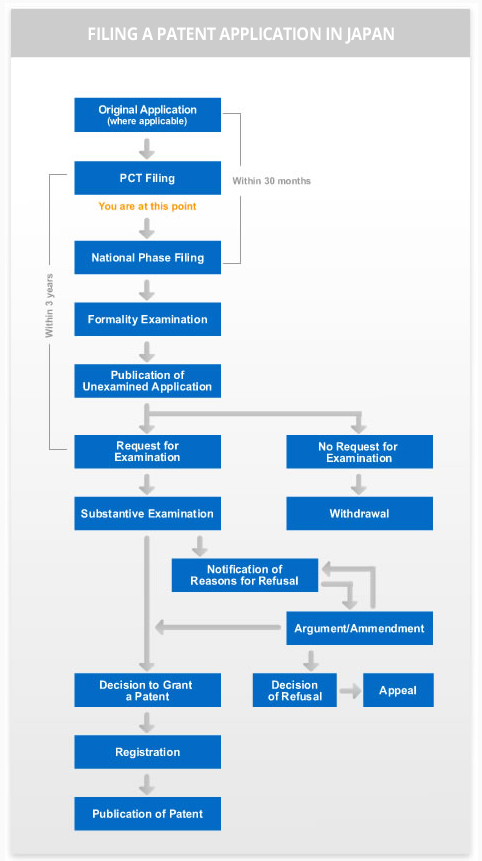Features of PCT National Phase Entry Course
We, the Tsubame IP Law Firm, provide accurate and high quality Japanese translations for PCT applications, as well as claims proposals based on the Office Action issued by the Japan Patent Office. In addition, we aim to acquire patent rights by holding an accurate grasp on the invention while answering the Office Action. Especially for handling the Final Rejection, we are actively utilizing the Appeal system and have successfully achieved a high grant rate. These high-quality services will be provided to you at a low price.
Fees for Japanese National Phase Entry
- ※ Translation Fee English → Japanese USD 0.28 per English word German or French → Japanese USD 0.4 per German/French word
- ※ Fees for Filing an Examination Request Attorney Fee: JPY 10,000 Official Fee: JPY 106,000 + JPY 3,600 per claim
Filing a Patent Application in Japan
- 1.30-month time limit
- The deadline for entering the Japanese National Phase is 30 months from the earliest priority date.
- 2.The Japanese Translation
- Although the application may be filed in foreign language at the time of national phase entry, a Japanese translation is still required. The deadline to file a Japanese translation is 2 months after the date of national phase filing.
- 3.Substantive Examination deadline
- The deadline for filing a request for substantive examination for a patent application is 3 years from the date of international filing.
- 4.First-to-file system
- Japan has adopted the first-to-file system, which means that if two parties apply to file a patent for the same invention, it is the first party that will be granted the patent.
- 5.Application requirements
- To enter the National Phase, the following documents must be submitted
to the Japanese Patent Office (JPO).
- Japanese National Phase Entry Request (prepared by us)
- Translated specifications, including claims, abstracts and figures
- Translated amendments, if any

- 6.What is a Substantive Examination?
- A Substantive Examination is carried out by the JPO to decide whether a claimed invention should be patented or not. It will exam whether the application fulfills the legal requirements and decide if there are any reasons for refusal.
- 7.When is a Substantive Examination carried out?
- A Substantive Examination is only carried out by the JPO when requested by the applicant and involves an additional fee. If requested at the time of filing of the translation, we will waive the attorney fees.
- 8.How can I make sure the JPO will approve my patent?
- The JPO will consider the following points:
- Is it based on a technical idea that uses a law of nature?
- Does the idea have any industrial application?
- Did the idea exist before the current application was filed?
- Could the invention have been easily developed by a person skilled in this field?
- Will the invention contravene public order and morality?
- Do the descriptions in the specification conform exactly to the requirements for patentability?
- 9.Can I appeal a refusal?
- If the JPO finds out grounds for refusal, the applicant will received an Office Action.
The applicant is entitled to submit either an argument claiming that the invention differs from the prior art to which the Notification of Reasons for Refusal refers, or, alternatively, file an amendment to address the reasons for rejection.
- 9.If my patent application is successful
- If no reasons for refusal are found, the JPO will grant the patent. When the patent fee has been paid, the invention will be added to the Patent Register and assigned a patent number. A certificate of patent will be sent to the applicant to acknowledge this formal registration and the registered.
Patent will be published in the Patent Gazette.